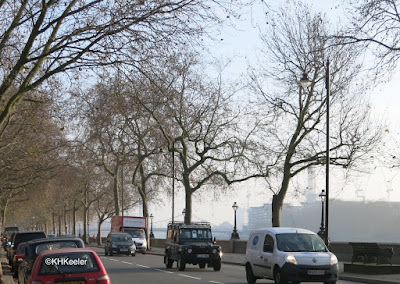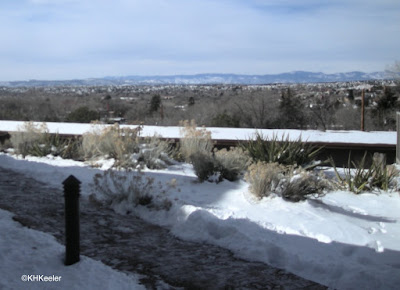 |
| London, December |
 |
| northern Colorado, December |
For example, European holly, Ilex aquifolia. (link) There were huge beautiful trees in London. It doesn't survive in Colorado.
 |
| Big European holly tree, Ilex aquifolia, London, December |
 |
| Camellia (Camellia sp.) with a flower, London, December |
But, look at the flowers:
 |
| Carnations; something had knocked them over but not interfered with flowering. London, December |
 |
| Nasturtium, London, December |
 |
| Cyclamen, London, December |
Of course, below freezing, the liquid in plants is a solid and won't flow up or down at all. So no biological activity is possible. Plants that survive where water freezes have insulated their roots well underground and/or incorporated"antifreeze" molecules. And of course reinforced their tissues against the mechanical damage of freezing.
The list of plants that "grow in London/ don't grow in Colorado" indicates that frost is rare in London. You can't grow a big camellia where there are severe freezes. If there had been a frost before I got there, I wouldn't have seen nasturtium or cyclamen flowers. Primarily, the ocean keeps London mild. With currents coming from the tropics (link), the Atlantic stays above freezing. The water shares heat with the land, most of the time keeping the land from freezing.
Probably, also, the area that is London freezes less often that in did when it was a small Roman town, because humans leak heat. We give off heat from our bodies and from our energy-burning activities from driving to cooking, and especially, heating buildings in order to live in pleasant temperatures. My area does not have 8 million people releasing heat.
Some of London's big trees had lost their leaves of course:
 |
| Along the Thames, London, December |
One London-in-December experience that my photos don't show is the day length. London was dark until 8 am and again before 4 pm. That reflected how far north we were. The days never get quite that short in northern Colorado.
One more contrast:
Citrus (grapefruit) at Chelsea Botanic Garden (see the green fruits?). Ok, they're proud to have the northernmost grapefruit tree. But good grief, not only can't Colorado grow any citrus, this one has green leaves in December.
 |
| Citrus, Chelsea Botanic Garden, London, December |
 |
| Landscape, Larimer County, Colorado, December |
If you live in the middle of a continent, check out the coasts some winter. And vice versa.
Questions and comments welcome.
Kathy Keeler, A Wandering Botanist
More at awanderingbotanist.com
Just found your interesting blog when googling red cabbage as a dye plant ... lol!
ReplyDeleteHad to comment on your statement above though ... "the least frost will kill nasturtiums (Trophaeolum spp. link) and cyclamen (Cyclamen spp.)."
Nasturtiums, yes. Cyclamen? Hahaha NO! There are several species which are hardy - coum and hederifolia are the two that come to mind. They wouldn't survive in my north of England rural garden at 700 ft otherwise. It's not cold by mid-continental standards here, of course, but I frequently have temperatures hovering around -5°C overnight, and 0°C during the day, from November to March, and expect frosts from late September to the end of May, or even later. The cyclamen flower at the same time as the snowdrops; the crocus take over from both of them.
London is another country, with a different climate, anyway!